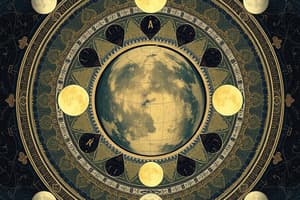Podcast
Questions and Answers
Differentiate between rotation and revolution.
Differentiate between rotation and revolution.
Rotation is spinning on an axis. Revolution is the movement of one object around another.
What causes day and night on Earth?
What causes day and night on Earth?
Day and night on Earth are caused by Earth's rotation on its own axis.
What determines a year on Earth?
What determines a year on Earth?
An Earth year is determined by the time it takes to complete an orbit around the Sun.
Differentiate between waxing and waning moon phases.
Differentiate between waxing and waning moon phases.
Differentiate between gibbous and crescent moon phases.
Differentiate between gibbous and crescent moon phases.
Differentiate between full and new moon phases.
Differentiate between full and new moon phases.
List the phases of the moon in order, beginning with a New Moon.
List the phases of the moon in order, beginning with a New Moon.
What are the positions of the Sun, Earth, and Moon during a full moon?
What are the positions of the Sun, Earth, and Moon during a full moon?
What are the positions of the Sun, Earth, and Moon during a new moon?
What are the positions of the Sun, Earth, and Moon during a new moon?
Why do we have day and night on Earth?
Why do we have day and night on Earth?
What do we call the time it takes Earth to make a complete trip around the sun?
What do we call the time it takes Earth to make a complete trip around the sun?
About how long does it take the Earth to completely rotate on its axis?
About how long does it take the Earth to completely rotate on its axis?
Differentiate between a Lunar and Solar Eclipse.
Differentiate between a Lunar and Solar Eclipse.
Explain why total solar eclipses are rare.
Explain why total solar eclipses are rare.
What shape is the Earth's orbit around the sun?
What shape is the Earth's orbit around the sun?
What is the cause for Earth's ocean tides?
What is the cause for Earth's ocean tides?
Differentiate between a spring tide and a neap tide (including the position of the Sun, Moon, and Earth).
Differentiate between a spring tide and a neap tide (including the position of the Sun, Moon, and Earth).
What phase(s) of the moon occur during a spring tide?
What phase(s) of the moon occur during a spring tide?
What phase(s) of the moon occur during a neap tide?
What phase(s) of the moon occur during a neap tide?
Which type of tide has the largest tidal range?
Which type of tide has the largest tidal range?
Illustrate and explain the reason for the seasons on Earth.
Illustrate and explain the reason for the seasons on Earth.
Flashcards are hidden until you start studying
Study Notes
Rotation vs. Revolution
- Rotation: The spinning of an object on its axis.
- Revolution: The movement of one celestial body around another.
Day and Night
- Caused by Earth's rotation on its axis.
- When a location rotates away from the Sun, it experiences night.
Definition of a Year
- A year on Earth is defined by the time it takes to complete one orbit around the Sun.
Waxing vs. Waning Moon Phases
- Waxing Phases: More of the moon is visible each night.
- Waning Phases: Less of the moon is visible each night.
Gibbous vs. Crescent Moon Phases
- Gibbous Phases: More than half of the moon's surface is illuminated.
- Crescent Phases: Less than half of the moon's surface is illuminated.
Full vs. New Moon Phases
- Full Moon: Entire surface of the moon is visible.
- New Moon: The moon is not visible from Earth.
Sequence of Moon Phases
- Order: New moon, waxing crescent, 1st quarter, waxing gibbous, full moon, waning gibbous, 3rd quarter, waning crescent.
Celestial Positions During Full Moon
- Alignment: Sun → Earth → Moon.
Celestial Positions During New Moon
- Alignment: Sun → Moon → Earth.
Cause of Day and Night
- Day and night result from Earth's rotation on its axis.
Duration of a Year
- One year is the time taken by Earth to orbit the Sun.
Duration of Earth’s Rotation
- Earth takes approximately 24 hours to complete one rotation on its axis.
Lunar vs. Solar Eclipses
- Solar Eclipse: Occurs when the Moon's shadow blocks the Sun as viewed from Earth.
- Lunar Eclipse: Occurs when Earth's shadow covers the Moon.
Rarity of Total Solar Eclipses
- Require precise alignment of Sun, Earth, and Moon; limited area of visibility due to Moon's shadow.
Shape of Earth's Orbit
- Earth's orbit around the Sun is elliptical.
Ocean Tides
- Caused primarily by the gravitational pull of the Moon.
Spring vs. Neap Tides
- Spring Tide: Higher high tides and lower low tides; occurs when Sun, Earth, and Moon are aligned.
- Neap Tide: Lower high tides and higher low tides; occurs when Sun, Earth, and Moon form a right angle.
Moon Phases During Spring Tides
- Occur during New Moon and Full Moon.
Moon Phases During Neap Tides
- Occur during 1st Quarter and 3rd Quarter.
Tidal Range
- Spring tides generate the largest tidal range.
Reason for the Seasons
- Earth's axial tilt causes varying sunlight intensity; the tilted hemisphere towards the Sun experiences summer, while the opposite hemisphere experiences winter.
Studying That Suits You
Use AI to generate personalized quizzes and flashcards to suit your learning preferences.




